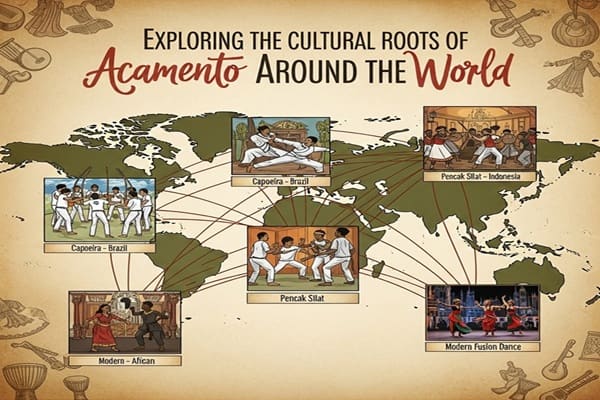Imagine a celebration so vibrant, so full of life, that it brings people together across continents. That’s Acamento—more than just a festival or event, it’s a living testament to culture, heritage, and community. From colorful street parades in bustling cities to intimate village rituals, Acamento embodies the spirit of togetherness and identity.
In this guide, we’ll explore the history, traditions, and modern adaptations of Acamento around the world, uncovering why it continues to capture hearts everywhere.
What Exactly is Acamento?
At its core, Acamento is about connection and celebration. It refers to cultural events worldwide that honor tradition, bring people together, and celebrate milestones—be it a birth, marriage, harvest, or community achievement.
Here’s what makes Acamento special:
-
Expression of Identity: Every culture adds its own flavor, creating unique but relatable experiences.
-
Joy and Reflection: Through music, dance, food, and storytelling, participants immerse themselves in their heritage while making new memories.
-
Intergenerational Bonds: Acamento strengthens ties between generations, preserving traditions while encouraging cultural pride.
Think of it as a cultural heartbeat—a ritual that celebrates who we are, where we come from, and what unites us.
A Glimpse into the History of Acamento
The origins of Acamento are as rich and diverse as the celebrations themselves. Historians believe it began as a rite of passage, marking transitions from youth to adulthood.
-
Agricultural Roots: In many regions, Acamento coincided with planting or harvest seasons, honoring deities tied to fertility and abundance.
-
Community Gatherings: Rituals provided opportunities for collective reflection and celebration, reinforcing social cohesion.
-
Cross-Cultural Exchange: As trade routes expanded, traditions blended, creating new regional variations while maintaining a focus on unity and shared experiences.
Over time, Acamento evolved. Today, it reflects both historical significance and contemporary culture, demonstrating how traditions can adapt without losing their essence.
How Acamento is Celebrated Around the World
Acamento takes many forms depending on cultural context. Each interpretation carries its own charm and meaning:
Brazil: Carnival Meets Tradition
-
Streets fill with music and dance.
-
Colorful costumes represent heritage and creativity.
-
Community joy is the heart of the festival.
Africa: Communal Unity
-
Drumming and rhythmic music set the tone.
-
Families gather for storytelling and shared meals.
-
The focus is on belonging and strengthening community bonds.
India and Parts of Asia: Spiritual Reverence
-
Rituals involve offerings to deities or ancestors.
-
Emphasis on respect for lineage and tradition.
-
Celebrations can be both intimate and elaborate, blending reverence with festivity.
No matter the form, the essence remains the same: connection, joy, and cultural expression.
Traditional Rituals That Make Acamento Special
Acamento is rich in rituals that honor both community and heritage. While they vary by culture, some common practices include:
-
Music and Dance: Drumming, singing, and dance create an immersive atmosphere.
-
Food Offerings: Traditional dishes symbolize abundance, passed down through generations.
-
Storytelling: Elders share tales linking participants to their ancestors.
-
Handcrafted Decorations: Preparing handmade items fosters collective pride and preserves cultural knowledge.
Each ritual is more than a performance—it’s a way of keeping history alive and making cultural identity tangible.
Also Read : Unveiling the Secrets of AmateurAllure: Tips for Newcomers
Acamento in the Modern World
While deeply rooted in tradition, Acamento has embraced modernity in remarkable ways:
-
Virtual Celebrations: Families separated by distance can participate via online platforms.
-
Social Media Influence: Platforms like Instagram and TikTok showcase vibrant celebrations, inspiring younger generations.
-
E-Commerce and Crafts: Artisans sell handmade Acamento items globally, supporting local economies while spreading awareness.
-
Urban Workshops: Cities now host interactive sessions, allowing people to learn rituals firsthand.
These modern adaptations demonstrate how tradition and innovation can coexist, keeping Acamento relevant in the 21st century.
Globalization and Its Effect on Acamento
Global connectivity has reshaped cultural practices, and Acamento is no exception:
-
Fusion of Styles: Modern music, dance, and visual arts blend with traditional practices.
-
Broader Awareness: Social media spreads cultural knowledge globally, attracting interest beyond native communities.
-
Challenges: Some rituals risk losing authenticity as they adapt to global trends.
Navigating this balance is crucial. Communities must preserve the core values of Acamento while allowing space for innovation and creativity.
Preserving the Cultural Significance
Acamento’s survival depends on intentional preservation:
-
Festivals and Local Events: Active participation keeps traditions alive.
-
Education and Workshops: Teaching younger generations ensures knowledge transfer.
-
Digital Documentation: Sharing rituals online promotes cultural awareness globally.
By combining community engagement with modern tools, cultures ensure that Acamento remains a living tradition, not just a historical footnote.
Why Acamento Matters Today
Beyond celebration, Acamento plays a vital role in cultural identity:
-
Strengthens Community Bonds: People come together to share joy and reinforce social ties.
-
Encourages Cultural Pride: Participants connect with their heritage in meaningful ways.
-
Inspires Creativity: Modern adaptations encourage new expressions while honoring tradition.
Whether in bustling cities or remote villages, Acamento shows us how tradition and community thrive together, reminding us of the universal human desire to celebrate life.
Conclusion: Embrace the Spirit of Acamento
Exploring Acamento reveals a festival that’s both ancient and modern, intimate and universal. Its layers—rituals, music, food, storytelling—paint a vivid picture of humanity’s shared values.
While globalization introduces challenges, it also opens doors for cross-cultural appreciation and innovation. Communities worldwide are finding ways to honor tradition while embracing change, ensuring that Acamento remains alive for future generations.
Ultimately, Acamento is more than just a celebration—it’s a living testament to culture, unity, and joy. Whether you participate in person or witness it online, its spirit inspires connection, creativity, and pride in our shared human heritage.
